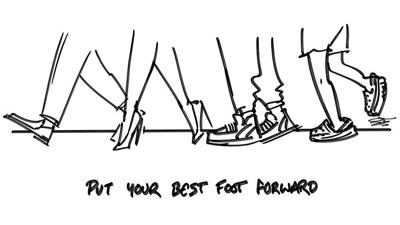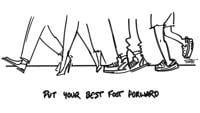I have this thing about shoes.
The moment I step into a crowded elevator or take a seat in a doctor’s waiting room, I notice the shoe types and brands my public fellows are wearing. Nike high-tops. Skechers slip-ons. Columbia hiking boots. Hoka running shoes. Adidas flip-flops. The variety is almost endless. (Me, I tromp around in nice, light Saucony running shoes. More on that later.)
And I wonder, when was the last time the folks I’m observing appreciated this humble and hard-working member of their daily wardrobe?
The truth is, like the late comedian Rodney Dangerfield said, your shoes “don’t get no respect.” That is, until you don’t have them and the terrain gets rough.
This was dramatically illustrated in the 1988 movie “Die Hard,” which I rewatched recently. The main character, New York City policeman John McClane, single-handedly battles a gang of ruthless terrorists taking over a Los Angeles office tower – in his bare feet! Caught shoeless when the fighting starts, he leaves trails of blood from stepping through broken glass.
You want to say, “Will somebody please find our hero some shoes?”
We could say the same thing about our wasteful world. The average American owns anywhere from six to 12 pairs of shoes. In Nevada, the average is 19 pairs. (I guess long nights at the gaming tables are hard on your feet.) Meanwhile, one billion people on Earth have no shoes. That includes 300 million children.
I can’t imagine going barefoot for any length of time, with the rare exceptions of at swimming pools and beaches. I am truly a “tenderfoot.”
On my personal shoe tree hang seven pairs, including two sets of dress shoes I haven’t worn in years. As my family can attest, I am beyond finicky in my shoe purchases. The shoe stores in our area just don’t carry what I’m looking for; it’s complicated by my having to wear orthotics and a lift in my right shoe.
So I try to buy shoes online, as many people do, and more often than not they are “off’ somehow and I send them back. One pair of walking shoes I ordered advertised two easy Velcro-fasteners, and I was so confident these would work that I bought two pairs, black and brown. I waited three weeks for the delivery. The moment I put them on I felt like Frankenstein – my steps heavy and stiff. It was more of a work shoe for people on their feet all day, not for real walking. So beware how shoes are described when you buy online. Fortunately, returns at Amazon or Zappos are simple.
I yearn for the shopping experience of my childhood, going to the shoe store with the creaky wood floors and the magical stainless-steel footpads with knobs for measuring width and length. And a shoe salesman (always an older man) waiting on you hand and foot (ahem).
Then I got older and started distance running as a teenager, including marathon training. This was in the early 1970s before Nike tapped into the U.S. running boom and became the colossus of the athletic shoe world.
My running buddies and I looked forward to the regular visits by an enterprising itinerant “shoe man” named Dick Pond, who sold the latest Adidas, Puma and Reebok models out of a catering truck and caught the Nike wave early on. With his shoes, I ran faster and longer – or at least felt I was.
I later ran track and cross country at the University of Missouri-Columbia and learned the hard way that not all running shoes are created equal. The athletic department gave me a pair from a new company in the business (I won’t name it), and I got a bad case of tendonitis in my knees that ended my career as a Mizzou runner.
Back to the shoeless people of the world. There are numerous charitable organizations addressing shoelessness around the globe, notably Souls4Soles, TOMS (part of Save the Children) and Hav a Sole, a California-based nonprofit sponsored in part by the National Basketball Association Foundation.
The Salvation Army and Goodwill Industries also accept shoe donations. Each of these organizations take in all new and gently used shoes – keyword “gently.” Don’t donate shoes with worn-out soles, or holes or tears in the upper shoe. If you wouldn’t wear them, don’t donate them.
As you can imagine, shoes also are part of ministering to needy families.
“We supply clothing as well as food, and shoes are a part of that,” said Chuck Beasley, entering his second year as director of the Jefferson County Rescue Mission in Pevely. “It’s important that we have them to give along with the clothing, but it’s not a critical thing. In a month’s time we may give out a dozen (pairs).”
The mission has two boxes for drop-off donations 24/7. The most needed type of shoe is casual.
“You can watch the shelves,” Beasley said. “Shoes that stay for a long time are dress shoes; most of our clients are really not interested in (them).”
Beasley ranked food, clothing and household goods as the top three priorities for their ministry, with shoes at No. 4. But for some people it can be No. 1.
“Occasionally we have somebody show up at our door barefoot,” he said.
I’ll let a famous expert have the last word.
“Give a girl the right shoes,” said Marilyn Monroe, “and she can conquer the world.”




